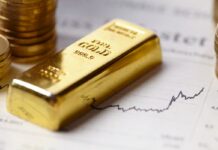Gold shattered a historic barrier this week, breaking above USD 4,000 per ounce for the first time, as a perfect storm of economic uncertainty, political turmoil, and a dovish shift in US monetary expectations sent investors rushing to the world’s oldest safe haven.
The record-breaking rally reflects deep unease across global markets. A prolonged US government shutdown, now entering its second week, has disrupted the release of key economic data, complicating the Federal Reserve’s ability to gauge the health of the economy. With policymakers effectively “flying blind,” investors are increasingly betting on pre-emptive interest rate cuts to cushion the labour market and sustain fragile growth momentum.
Futures markets now price in 25-basis-point reductions at both the October and December Fed meetings — a dovish trajectory reinforced by recent remarks from several Fed officials hinting that monetary easing could arrive sooner than expected. The combination of policy uncertainty and expectations of lower real yields has proven fertile ground for gold’s ascent.
Policy Paralysis and Political Risk Drive Haven Demand
While US policy signals have been central to gold’s climb, the rally has also been amplified by political turbulence abroad. In France, an escalating leadership crisis has deepened concerns about European stability, with markets bracing for possible snap elections or fiscal disruptions. In Japan, the abrupt resignation of Prime Minister Yoshihiro Tanaka — the third leadership change in just five years — has further unsettled investors already wary of slowing Asian growth.
These developments have pushed risk-averse capital towards precious metals, reinforcing gold’s role as a hedge against both currency volatility and political upheaval. The broader backdrop of global instability — spanning Europe, the Middle East, and Asia — has strengthened the metal’s appeal at a time when confidence in traditional assets remains fragile.
ETF Inflows Reach Record Highs
Institutional and retail demand has surged in tandem. Exchange-traded funds (ETFs) tracking physical gold saw unprecedented inflows through the third quarter, as asset managers sought to hedge portfolios against inflationary pressures, policy missteps, and market shocks.
According to industry data, US-listed gold funds attracted a record USD 35 billion by the end of September, eclipsing the previous annual peak set in 2020 during the height of the pandemic. Globally, year-to-date inflows reached USD 64 billion, with September alone adding USD 17.3 billion in new allocations. Analysts say this surge underscores a structural shift in sentiment, as investors re-evaluate gold’s role within diversified portfolios.
“Gold has effectively become the world’s default hedge in an era where traditional safe assets like government bonds are constrained by low or negative real yields,” said one London-based commodities strategist. “It’s not just retail investors — institutional money is moving decisively into bullion.”
Geopolitical Flashpoints Sustain Bullish Momentum
The metal’s momentum has also been underpinned by geopolitical flashpoints. Efforts to broker a ceasefire between Israel and Hamas in Cairo entered a third day on Wednesday, but reports of continued airstrikes and cross-border attacks have tempered hopes of a breakthrough. Meanwhile, tensions in Eastern Europe show little sign of easing, with renewed military activity along key border regions heightening investor anxiety.
Against this backdrop, analysts expect gold’s resilience to persist. “Every major source of uncertainty — from central bank ambiguity to political fragmentation — currently supports the case for higher gold prices,” noted another strategist. “The question is less about whether gold will hold above $4,000, and more about how long the underlying drivers will remain in place.”
A Turning Point for Precious Metals
For now, bullion’s rise above the $4,000 mark marks a psychological turning point for the precious metals market. While some analysts warn of potential short-term profit-taking, most agree that the structural environment — defined by monetary loosening, geopolitical instability, and sustained investment inflows — remains firmly in gold’s favour.
Should the Federal Reserve confirm a shift toward easing in its upcoming meetings, and if global political tensions remain elevated, the rally could extend further — positioning gold as one of the defining assets of the 2025 market cycle.









































